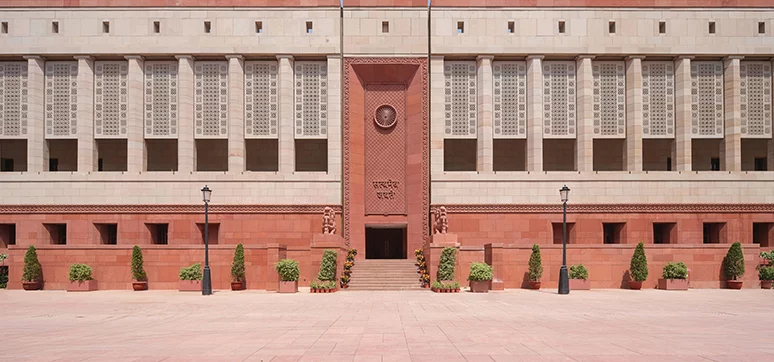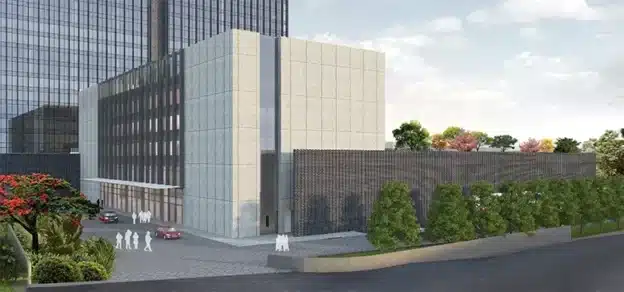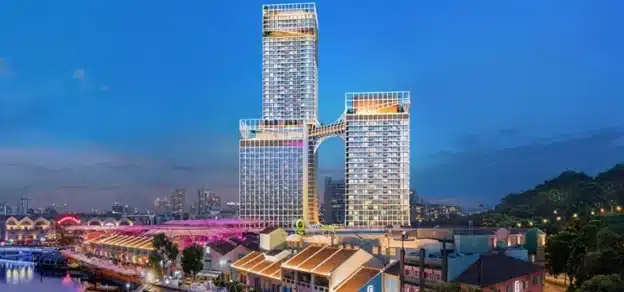Throughout the ages, natural stone has been the preferred choice of material for construction, effortlessly blending strength and elegance into timeless designs. From the Mayans, Dravidians, Greeks and Romans to modern architects, its allure has transcended ages. Not just architecture, natural stone is also captivated as a medium for sculptures. Artists such as Michelangelo and Bernini transformed blocks of marble into timeless masterpieces, breathing life into stone and showcasing its expressive potential.
Its eco-friendly essence is a cornerstone of its appeal. Derived/Borrowed from the earth, it aligns with sustainable practices. Its longevity reduces waste, echoing a responsible ethos. Natural stone cladding effortlessly marries durability with aesthetics. It’s also preferred for subtle imperfections to add an authentic touch, its organic nature and tone variations. Its robustness and endurance safeguard structures against the ravages of time and nature and help you leave behind a smaller ecological footprint.
The installation of natural stone cladding is an intricate process that demands both skill and precision. To achieve a safe and reliable fixing system for stone cladding, it is essential to fully consider the implications of the weight and properties of natural stone, early on in the design work. Weight is the primary area of concern when building with stone. Fundamentally, you are talking about adhering or attaching a very heavy material to a vertical surface. The installation process requires ensuring that each stone finds its place within the design while considering load distribution, thermal bridging and material compatibility.
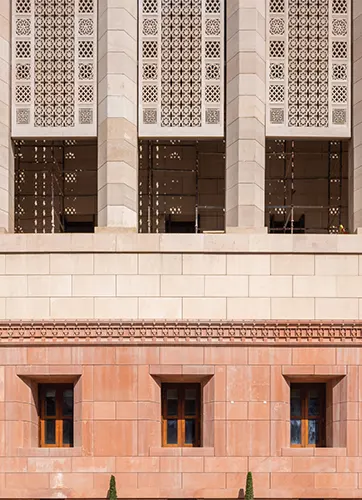
Dry cladding directly on the structure of a building is a construction technique where cladding materials are attached directly to the main structural elements, with or without the use of a substructure made of steel or other framing materials. This method is often referred to as “direct-fix” or “face-fixed” cladding. In this approach, the cladding material is typically secured to the building’s surface using fasteners, such as screws or nails.
The fasteners are directly driven into the structural substrate, providing a secure and stable attachment for the cladding. Two common types of fasteners used in dry cladding are regular fasteners and undercut fasteners, which have a unique design that allows for a hidden attachment, which means the fastener remains concealed behind the cladding material. This provides a clean and seamless appearance to the exterior surface of the building. Natural stone’s unique thermal properties offer a great advantage when it comes to energy efficiency. Its high thermal mass enables it to absorb, store, and gradually release heat, regulating indoor temperatures. This quality helps keep the heat out when it’s warm, which means we rely less on air conditioning and use less energy overall. This synergy with nature’s rhythm not only slashes utility bills but also promotes sustainable design strategies.
Natural stone cladding also contributes to improved acoustics within architectural spaces. The dense composition of the stone helps dampen the sound vibrations, creating tranquil interiors and shielding inhabitants from external noise pollution. As urban landscapes grow louder, the value of acoustically enhanced environments becomes ever more apparent, making natural stone cladding an asset in fostering serenity within bustling cities. From ancient wonders to modern times, the journey of natural stone cladding epitomises architectural evolution. Natural stone cladding is a marvel that harmonises durability, aesthetics, and ecological sensitivity. It creates spaces that breathe elegance and resilience while embracing sustainable principles. As architects and designers embrace the heritage and promise of natural stone cladding, they shape not just structures, but a greener future.
An Odyssey in Stone The New Parliament House, New Delhi
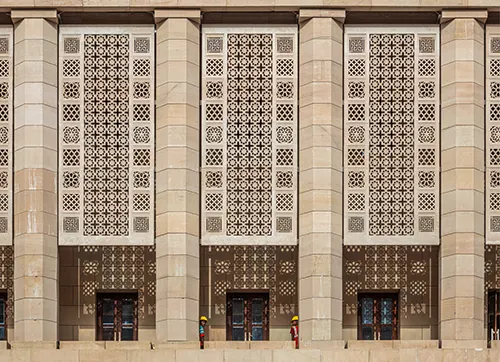
Some projects are chosen, not only for the legacy associated with them but also for the significant scale and timeline that demands collective and individual efforts from the entire organisation. The specialised stone latticework at the New Parliament House, New Delhi, in collaboration with Tata Projects, was one such landmark project in the history of our organisation. We, at Odyssey, were entrusted with the responsibility of creating the exterior and sandstone lattice screens for this iconic structure—the first purpose-designed Parliament building in India, in an extremely demanding timeline. It required each individual, and the entire organisation as a whole, to step up and tackle this head-on.
As a specialised fabricator and installer, our task involved procuring, sawing, carving, finishing, and installing 290 metric tonnes of Dholpur sandstone in the form of 70mm thick lattice screens. We source material directly from the quarry, to ensure consistency of raw material and two members of our team were stationed at the quarry during the entire procurement process.
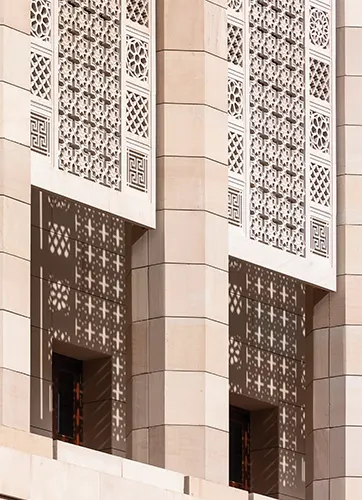
Simultaneously, we began the design and prototyping process which required close to 500 square feet of lattice prototypes in varying degrees of intricacy. We had to strike the right balance between achieving the correct degree of intricacy with the finer tools (such as the pencil/6mm diameter tool) and fabricating within the stipulated period. These prototypes were then placed at the heights where they would be viewed for final approval from the design team.
The lattice screens, totalling 14,200 square feet, are 3-dimensionally carved on the face and 2-dimensionally honed from the back side, as they would be visible from the inside of the building. This intricate work required over 75,000 CNC milling hours, 60,000 hand-finishing hours, and 25,560 man hours for installation. Over 45 CNC machines, operating for 22 hours a day were dedicated to this project and a team of 30 finishing craftsmen hand-finished.
The lattice screens are installed at a height of 80 feet and were pre-installed with undercut fasteners, and mechanical fasteners to streamline the delivery and installation process. Due to the sheer number of agencies simultaneously involved in finishing this monumental project, every second and square foot on the job site was accounted for. This required precision to the highest degree, and we had to create stencils of every individual metal sub-frame and mark them on each lattice for the positioning of the undercut fasteners.
There are a total of 78 full lattice panels, which are a composition of nine individual panels. Each lattice panel, with outer dimensions of 2400mm x 600mm x 70mm and weighing 750 kilograms each, was installed at a height of 80 feet. The meticulously crafted sandstone lattice screen draws inspiration from the country’s rich architectural heritage These beautifully carved screens adorn the first-floor verandahs, providing shade and enhancing the building’s aesthetics.
Odyssey’s contribution to the new Parliament building in New Delhi is a testament to our commitment to excellence and dedication. The sandstone lattice screens will stand as an enduring symbol of beauty and functionality, illuminating the interior spaces with a touch of tradition. As we continue to grow and evolve as a company, we take immense pride in leaving a lasting legacy that showcases our passion for artistry and innovation.
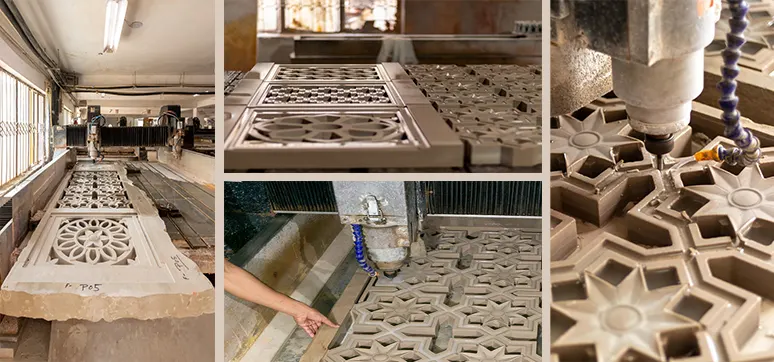
QUICK FACTS:
- Project: New Parliament House
- Location: New Delhi
- Client: Tata Projects Limited
- Architect: Ar. Bimal Patel
- Other Consultants: Rajeev Lunkad – DirectCreate
- Architectural Hardware used: Sand Stone /Hilti Machine, 3-axis CNC Machines, overhead cranes
- Commencement Date: June 2022
- Completion Date: February 2023
